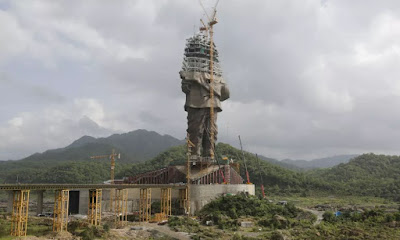Sardar Patel statue to stand 182m tall, then
be surpassed in 2021
By Michael Safi
 |
|
The
Statue of Unity will be unveiled on 31 October. Photograph: Ajit Solanki/AP
|
India says it will unveil the world’s largest statue next
month, depicting the independence leader Sardar Patel.
However, the reign of the 182-metre structure
as record holder could be short-lived, with work due to begin on an even larger
statue of a Hindu king off the coast of Mumbai.
The two statues have strong resonance for the
Hindu nationalist movement, which has been on the rise in India, and will cost
a total of nearly £700m to build.
Sign up to the Art Weekly email
Read
more
The Gujarat state chief minister, Vijay
Rupani, confirmed the Sardar Patel statue, located about 125 miles (200km)
south-east of the state’s commercial capital, Ahmedabad, would be unveiled on
31 October.
The 29.8bn rupee (£314m) Statue of Unity,
which Rupani said is being built with iron, water and soil collected from
across India, will be about twice the size of New York’s Statue of Liberty.
The planned height of the Mumbai structure,
depicting the 17th-century Marathi ruler Chhatrapati Shivaji, was increased
this year. Officials made the change after they learned China had raised the
height of the Spring Temple Buddha, which is currently the world’s largest
statue at 128 metres, not including its base.
“It prompted us to revise our design and
increase the height to 212 metres,” the Maharashtra chief minister, Devendra
Fadnavis, said.
The Patel statue was commissioned by the
prime minister, Narendra Modi, when he was Gujarat’s leader in 2013.
Hindu nationalists have adopted Patel, who
was born Vallabhbhai Jhaverbhai Patel, as an icon. The “iron man of India” is
revered for persuading, sometimes with threats of force, the more than 550
princely states that existed in the country during the colonial era to join the
Indian union.
Modi has lamented that Patel was passed over
for the role of prime minister after independence – he was the deputy to
Jawaharlal Nehru. Modi claimes – wrongly, according to historians – that the
disputed region of Kashmir would have been fully Indian had Patel become
leader.
Historians say the reverence for Patel is an
attempt to sideline Nehru, the proponent of a secular India which is at odds
with the religious nationalists’ vision of a Hindu rashtra, or nation.
“They’ve been trying to appropriate Patel for
years, because they don’t really have a position in the freedom movement
themselves,” said Anirudh Deshpande, an associate professor of history at Delhi
University.
The Shivaji statue is scheduled to be
completed around 2021 at an estimated cost of nearly £380m.
Shivaji, shown in the statue on a horse with
his sword drawn, fought wars against Muslim Mughals and other Indian and
foreign rulers for years to establish his own kingdom on the Arabian sea.
Since his death in 1680 he has become a
symbol of Hindu sovereignty and resistance to Muslim rule. However, many
historians argue medieval Indians had a nuanced understanding of religious
difference and did not relate to each other as monolithic Hindu or Muslim
groups.
According to a security proposal submitted to
the city authorities, the statue will stand on an island about 2,000 metres out
to sea that will be patrolled by speedboats and ringed by a 14-metre fortified
wall.
A complex attached to the structure will
house a museum, food court, art gallery, viewing deck, amphitheatre and
helipad.
The proposal has upset fishermen, who say the
6.8ha of land that needs to be reclaimed to build the statue will damage the
environment. Residents have also questioned why, in a city of striking poverty
and underfunded hospitals and schools, so much money is being spent on the
structure.
“This is taxpayers’ money and I am sure we
would all like this money to be spent on something better like education,
infrastructure, and food,” said an online petition by a Mumbai journalist
Krishma Upadhyay opposed to the project.

